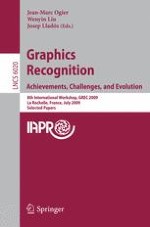This book contains refereed and improved papers presented at the 8th IAPR Workshop on Graphics Recognition (GREC 2009), held in La Rochelle, France, July 22–23, 2009. The GREC workshops provide an excellent opportunity for researchersand practitionersat all levels of experience to meet colleaguesand to share new ideas and knowledge about graphics recognition methods. Graphics recognition is a sub?eld of document image analysis that deals with graphical entities in engineering drawings, sketches, maps, architectural plans, musical scores, mathematical notation, tables, diagrams, etc. GREC 2009 continued the tradition of past workshops held in the Penn State University, USA (GREC 1995, LNCS Volume 1072, Springer Verlag, 1996); Nancy, France (GREC 1997, LNCS Volume 1389, Springer Verlag, 1998); Jaipur, India (GREC 1999, LNCS Volume 1941, Springer Verlag, 2000); Kingston, Canada (GREC 2001, LNCS Volume 2390, Springer Verlag, 2002); Barcelona, Spain (GREC 2003, LNCS Volume 3088, Springer Verlag, 2004); Hong Kong, China (GREC 2005, LNCS Volume 3926, Springer Verlag, 2006); and (GREC 2007, LNCS Volume 5046, Springer Verlag, 2008). The programof GREC 2009 was organized in a single-track 2-day workshop. It comprised several sessions dedicated to speci?c topics. For each session, there was an invited presentation describing the state of the art and stating the open questions for the session’s topic, followed by a number of short presentations thatcontributedbyproposingsolutionstosomeofthequestionsorbypresenting results ofthe speaker’swork. Eachsessionwas then concludedby a paneldisc- sion.
